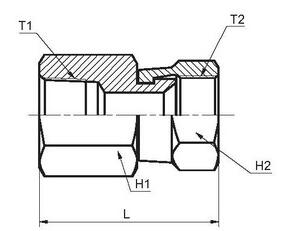

Contact us

Place seals such as O-rings and bai steel paper pads on […]
Place seals such as O-rings and bai steel paper pads on the plane, or apply sealant, sealant, etc. on the surface.More About :Flat Face Seal

Type of pressure vessel sealing(1) Smooth sealing surface Smooth sealing surface is also called flat sealing surface. The sealing surface is not a smooth plane. There are often 2 to 4 concentric grooves (flange water lines) distributed in a triangular section on the plane. Compared with other types, the smooth sealing surface is simple in structure and convenient to manufacture. Secondly, the width of the sealing surface of this structure is larger, so non-metal or metal soft gaskets are often used in use. It is widely used in occasions where the pressure is low or the consequences of leakage are not serious. At present, the soft gasket (wound type or high-purity aluminum gasket) can also receive satisfactory results when used under the conditions of PN=4MPa and DN=1000mm. After the sealing surface is damaged, it can be repaired with a soldering knife or a metal repair agent.
(2) The structure of the sealing surface of the concave and convex sealing surface is equivalent to a pair of flanges with smooth sealing surfaces, one of which is made of a pressing surface with a raised platform, and this flange is called a convex flange, and the other is corresponding The concave flange is called concave flange, and the gasket with the same size as the convex surface is embedded in it. The height of the convex surface is slightly larger than the depth of the concave surface, and it is compressed by bolts to act as a seal. For flanges with the same nominal diameter as the nominal pressure, the geometric width of the pressing surface of the concave flange is 5~10mm smaller than the width of the smooth sealing surface according to the current standard (JB1158—73). Compared with the smooth sealing surface, the same operating conditions and dimensions For flanges, the bolt force will be reduced. Secondly, this structure can limit the radial deformation of the gasket and improve the sealing performance to a certain extent. After the sealing surface of this structure is damaged, it can be repaired by a repair welding method or a metal repair agent.
(3) The tongue and groove sealing surface is in the middle of a pair of smooth sealing surfaces in the width direction, one of which is made into a cross section like a tenon, and the other section is like a groove. Groove flange. The tongue and groove sealing surface is generally 1/2 to 1/4 of the width of the smooth sealing surface. Good sealing performance, commonly used in high pressure or occasions where the pressure is not high but leakage is more harmful. The tongue-and-groove compression surface can limit the radial deformation of the embedded gasket, which is more advantageous for the compression of the gasket of cold fluid materials (such as PTFE, butadiene rubber). The sealing surfaces of convex and tenon-faced flanges are protruding, so they are more likely to be scratched than concave and grooved flanges. Once the sealing surface of the equipment connection flange is damaged, it is very troublesome to repair. Therefore, concave or grooved flanges should be used. But it should be noted that the valves are all concave or grooved flanges, so the pipe port connected with the valve should be convex or grooved flange. When the sealing surface is damaged, it can be repaired with a welding knife, grinding or metal repair agent.
(4) When the sealing surface of the trapezoidal groove and the conical sealing surface have high operating pressure or strict requirements on leakage rate, and high temperature or strong corrosiveness, metal gaskets can be used. The specific pressure of metal gaskets is very large. In order to reduce the bolt force, the pressing surface must be very narrow, relying on the extremely narrow pressing surface to maintain a good seal, and must have surface roughness (0.63 ~ 2.5m. Common structural forms include trapezoidal groove sealing surface and conical seal Surface. The former uses an elliptical cross-section annular metal gasket, and the latter uses a lens-type annular metal gasket. The above two structures are forced to seal and are commonly used in high-pressure parts.

Zhejiang Guolin Machinery Co., Ltd. is located in Taizhou, famous for“Famous Mountain at Sea”, a coastal city in the middle of Zhejiang Province.
Zhejiang Guolin Machinery Co., Ltd.
Get in touch with us via mail phone.We are waiting for your call or message
[email protected]Copyright © Zhejiang Guolin Machinery Co., Ltd. Rights Reserved.
China stainless steel fittings manufacturers hydraulic fittings Factory
Support by: HWAQ